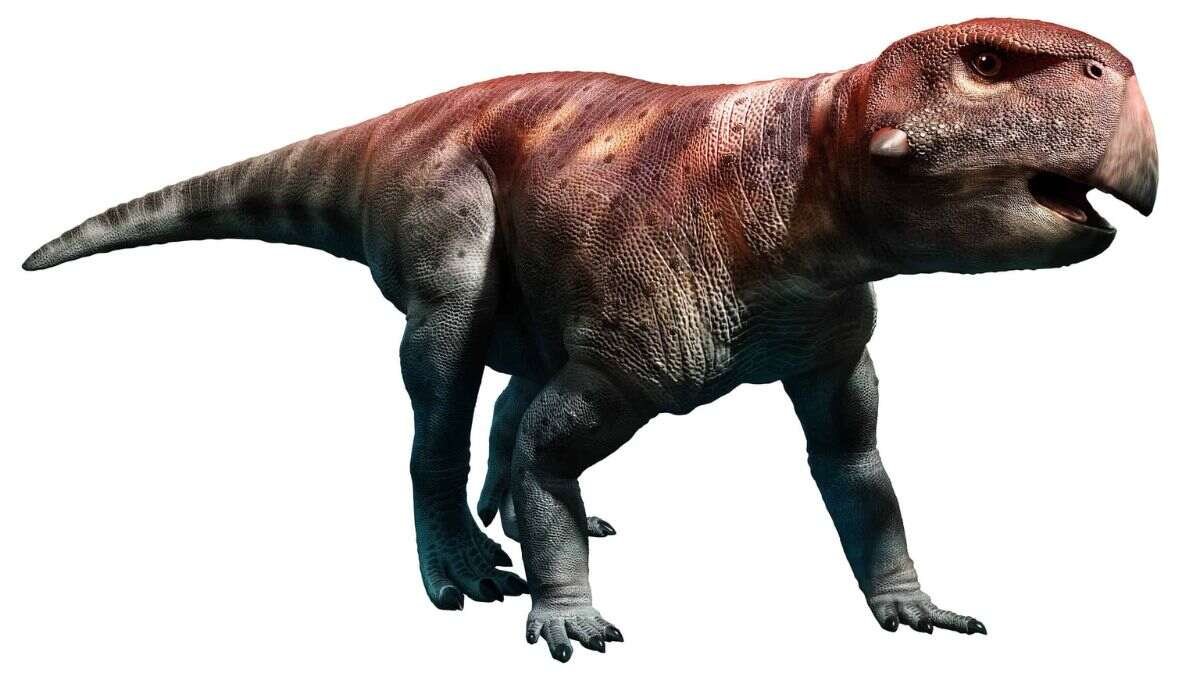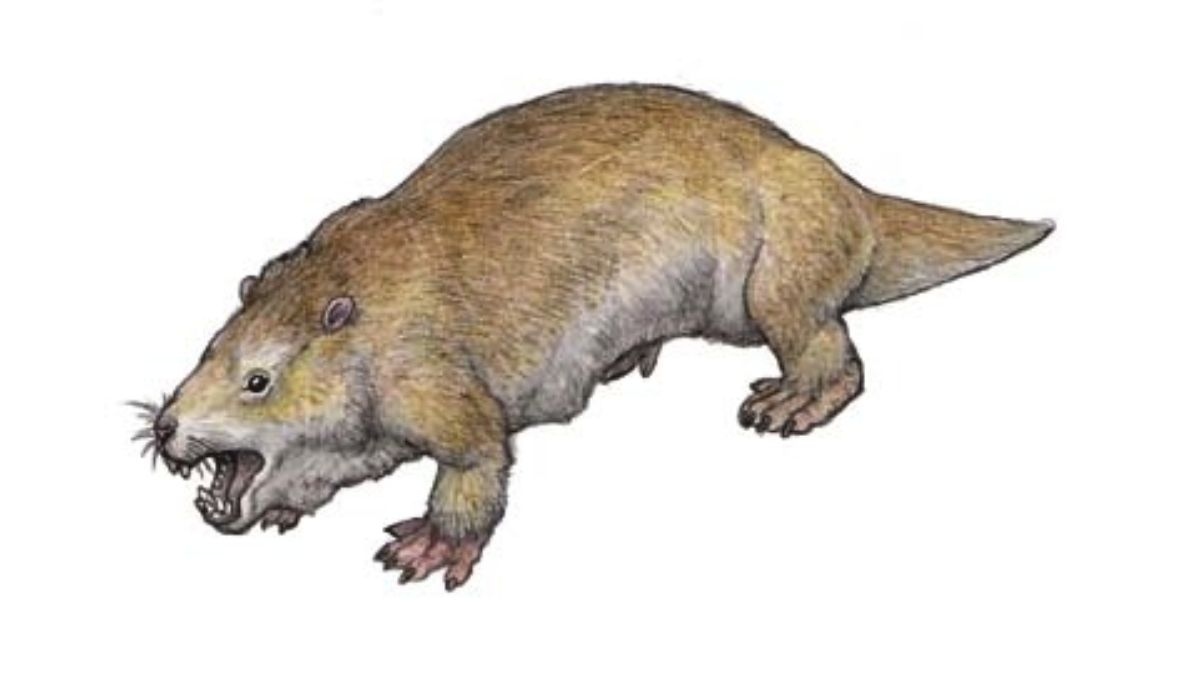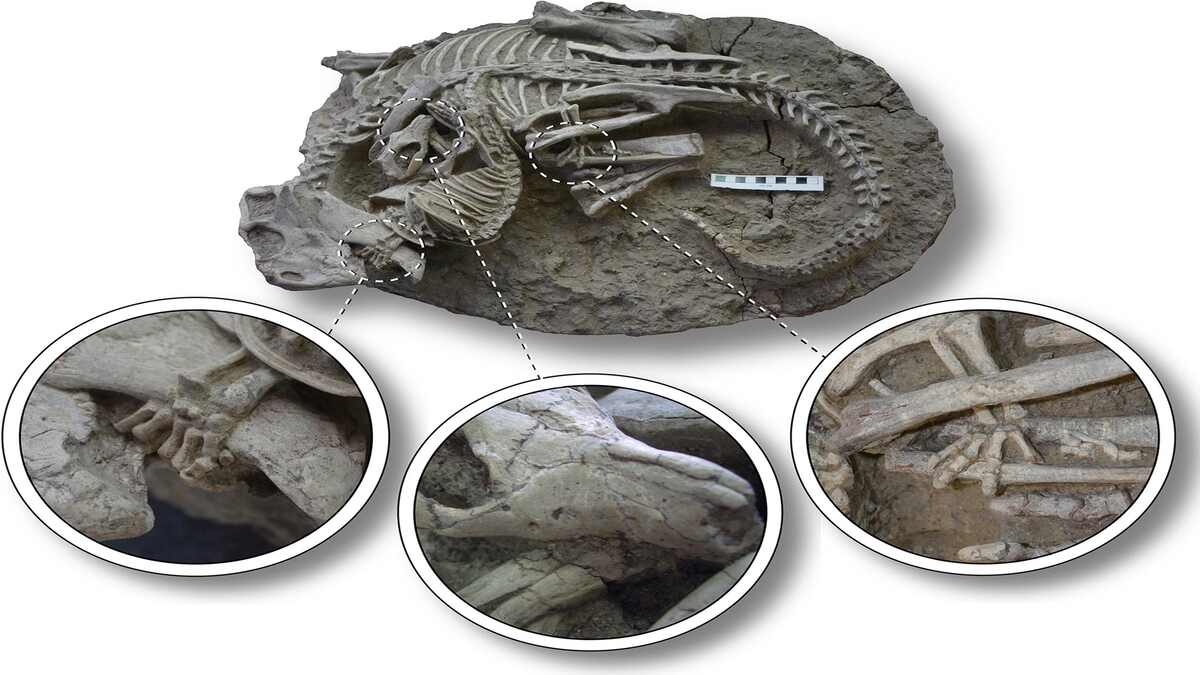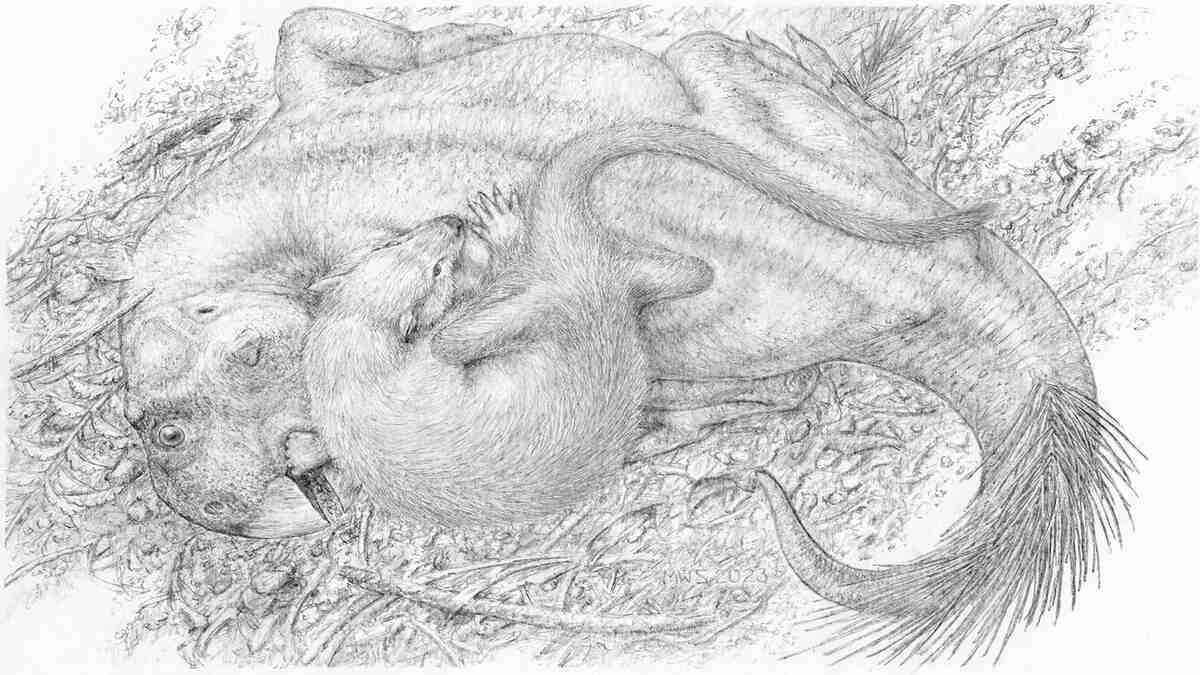For over 230 million years, dinosaurs and mammals have coexisted on Earth, shaping the course of evolution and leaving a profound impact on the planet's biodiversity. While both groups have thrived throughout history, direct evidence of their interactions has been rare, making fossil finds that shed light on their ancient interactions all the more extraordinary.
In a groundbreaking discovery that has captured the attention of palaeontologists worldwide, a new fossil from the Lujiatun Member of China's Lower Cretaceous Yixian Formation has unveiled a unique glimpse into the past. The fossil, designated as WZSSM VF000011, presents an incredibly rare scene of entwined skeletons, depicting a fierce struggle between a gobiconodontid mammal and a psittacosaurid dinosaur.
The Lujiatun Member of the Yixian Formation is well-known for its abundance of vertebrate fossils, particularly Psittacosaurus lujiatunensis, a small ceratopsian dinosaur that constituted almost 90% of the local fossil assemblages. The discovery site near Lujiatun Village in Liaoning Province has provided invaluable insights into the ancient ecosystem that thrived during the Early Cretaceous.
Identification

The dinosaur's skeleton is complete, allowing palaeontologists to confidently identify it as Psittacosaurus Lujiatunensis. Key diagnostic features, such as the width of the prefrontal bone relative to the nasal bone, and the contact between the quadratojugal and squamosal bones along the anterior margin of the quadrate shaft, confirm its identity. The dinosaur's body position in the fossil indicates that it was lying prone, with its hind limbs folded on either side of its body, while the neck and tail were curled to its left.
The mammal's skeleton is also remarkably well-preserved, although the distal end of its tail is missing. The preservation of key skeletal elements, such as its mandible and teeth, allowed experts to identify it as Repenomamus Robustus. While the mammal's mandibular and dental features were not entirely visible in the fossil, it's small size and unique characteristics, such as the weak sagittal and lambdoid crests and zygomatic arches, strongly suggest it is R. Robustus and not the larger R. Giganticus.

The most striking aspect of the fossil is the intimate entanglement of the two individuals. The mammal's left hand firmly grips the lower jaw of the dinosaur, and its left hindleg is trapped within the dinosaur's folded left leg, with its hindfoot gripping the dinosaur's shin just below the knee. The mammal's bite is focused on two of the dinosaur's left anterior dorsal ribs, which appear to be broken, suggesting a forceful and fatal attack.
The positioning and grasping behaviour of the mammal suggest that it was the aggressor in this ancient battle, while the dinosaur was seemingly in a defensive posture, attempting to ward off the attack. This interpretation aligns with previous research indicating that Repenomamus Robustus was a carnivorous mammal that likely preyed on smaller animals.
Role of Volcanic Debris Flow In Preserving The Fossil
The scientific team that conducted the research asserts that the two animals perished amid a conflict, ensnared by a volcanic mudflow that entombed them. As the Psittacosaurus exhibited no signs of biting elsewhere, the researchers firmly concluded that the mammal actively preyed on a live dinosaur rather than scavenging a carcass.

An alternative and more compelling explanation is that the mammal was actively preying on the weakened dinosaur when they were both buried. The mammal's position atop the dinosaur, gripping its lower jaw, and biting its ribs, suggests a predation attempt rather than scavenging behaviour. The sudden volcanic debris flow likely interrupted this fatal encounter, preserving it for millions of years and providing scientists with a unique window into this ancient drama.
The fossil's preservation and significance stem from the characteristics of the rock matrix in which it was found. Analysis of the sedimentary material revealed it to be a matrix-supported, medium-coarse brecciated tuff, indicative of a volcanic origin and the presence of a volcanic debris flow. This lahar-type volcanic debris flow event, occurring suddenly and violently, likely resulted in the entombment of the two combatants and played a crucial role in preserving this ancient battle scene.
ALSO READ| Huge Dinosaur Skeleton Unearthed in Portugal - Check details here
Comparison of the two species
The two entangled individuals represented in the fossil are a small dinosaur, Psittacosaurus lujiatunensis, and an even smaller mammal, Repenomamus Robustus. Psittacosaurus was a relatively small ceratopsian dinosaur, known for its beak-like mouth and leaf-shaped cheek teeth, indicating an herbivorous diet. Repenomamus, on the other hand, was a gobiconodontid mammal, a group of early mammals that displayed a mix of reptilian and mammalian characteristics.
Another fascinating aspect of the fossil find is the estimated body masses of the two individuals. The dinosaur, Psittacosaurus lujiatunensis, was approximately three times larger in mass than the mammal, Repenomamus Robustus. Despite the significant size difference, the fossil association falls well within the 95% prediction intervals for a linear model of maximum prey body mass vs. predator body mass among terrestrial carnivorans. This analysis indicates that the size difference between the two combatants was not an insurmountable obstacle for the mammal, challenging the notion that predators typically target prey close to their size.
Implications for the understanding of Mesozoic ecosystems

Indeed, modern-day examples of small carnivorous mammals preying on much larger animals support the plausibility of such an encounter. For instance, wolverines are known to occasionally attack prey many times their size, such as moose and caribou. This analogy suggests that the small mammal, Repenomamus Robustus, may have had similar predatory abilities and could have been a formidable hunter even for relatively large dinosaurs.
The discovery of this ancient battle scene not only provides insights into predator-prey interactions during the Mesozoic era but also highlights the exceptional preservation potential of obrution deposits resulting from catastrophic events like volcanic debris flows. The Lujiatun Member of the Yixian Formation, often referred to as the "Chinese Pompeii," has played a critical role in revealing the diverse fauna of small-bodied dinosaurs and other creatures from this period. As research in the area continues, palaeontologists anticipate further fossil discoveries that could shed even more light on the interactions between dinosaurs and mammals and the ecological dynamics of this ancient world.
Despite its smaller size, the mammal's predation attempt on the dinosaur challenges the common assumption that Mesozoic mammals were merely subordinate to their larger dinosaurian counterparts. The fossil provides evidence that Mesozoic mammals were more than mere bystanders and could pose a genuine threat even to fully-grown dinosaurs. Such insights into the dynamics of ancient ecosystems are invaluable for understanding the complex interactions between species and the factors that shaped their evolutionary trajectories.
Jordan Mallon, a paleobiologist at the Canadian Museum of Nature in Ottawa and co-author of the study, says,
“As productive as the fossil beds of the Lujiatun area are, there are still many unanswered questions about this ancient ecosystem. There’s a tendency for those fossil beds to preserve only the small animals that were around at the time. Presumably, the bigger dinosaurs were able to escape the volcanic mudslides that the smaller animals fell victim to, so I would love to know more about the big animals living in that area, which is going to require continued prospecting”.
ALSO READ| Have Dinosaurs Really Gone Extinct? We Doubt! Here Is A Dinosaur Hidden In This Picture. Find It If You Can!
Comments
All Comments (0)
Join the conversation